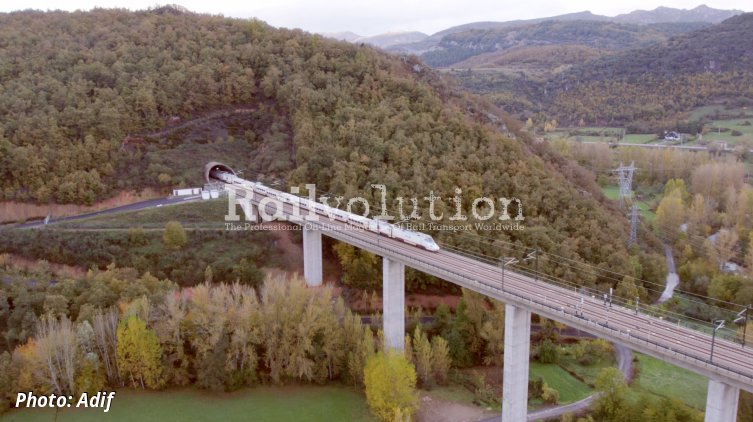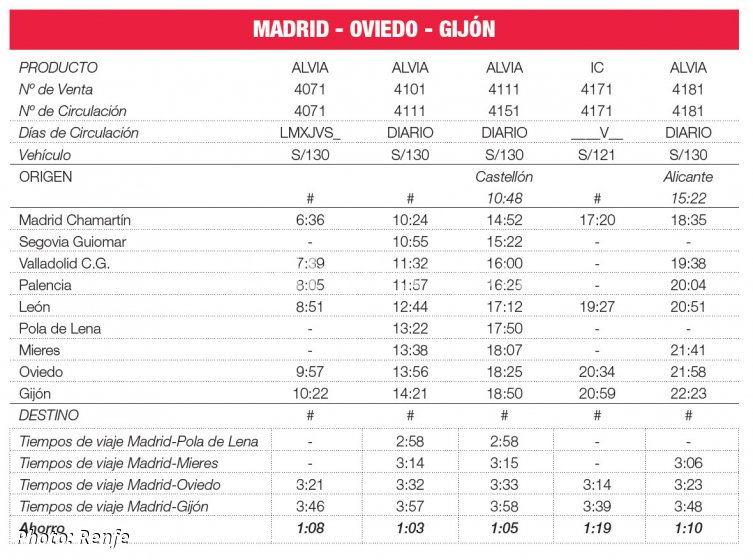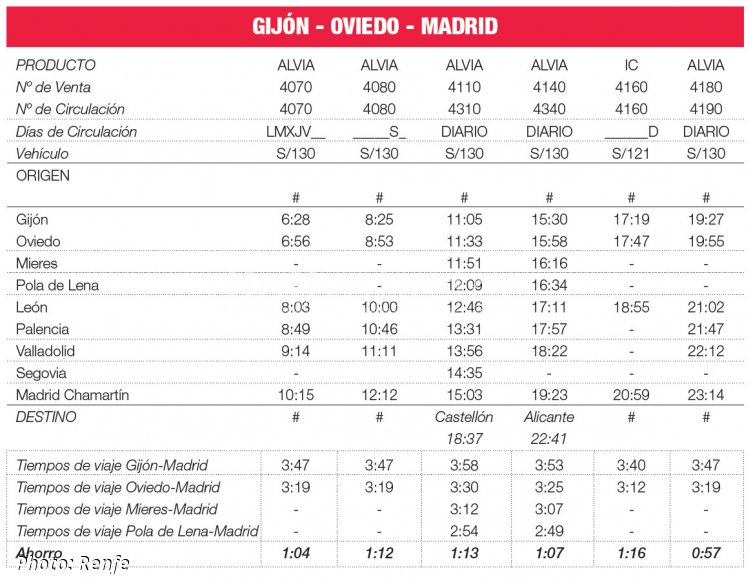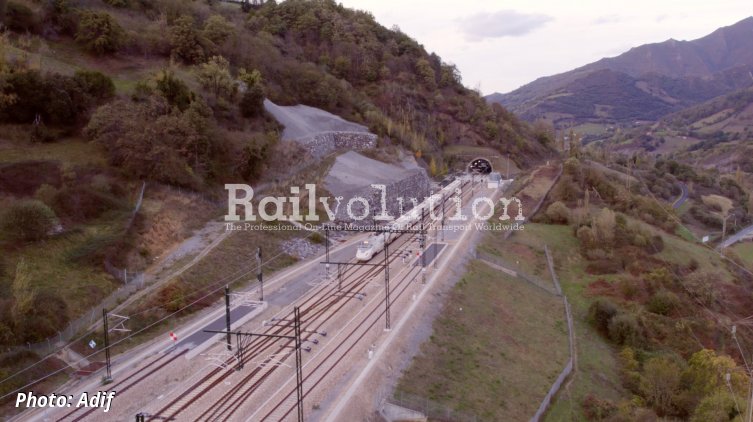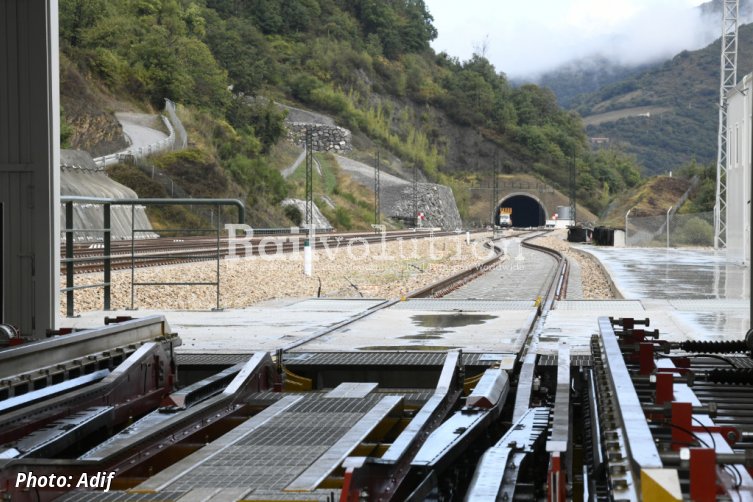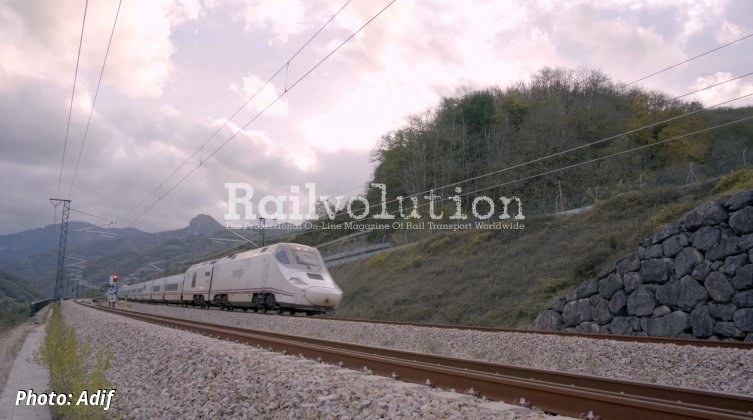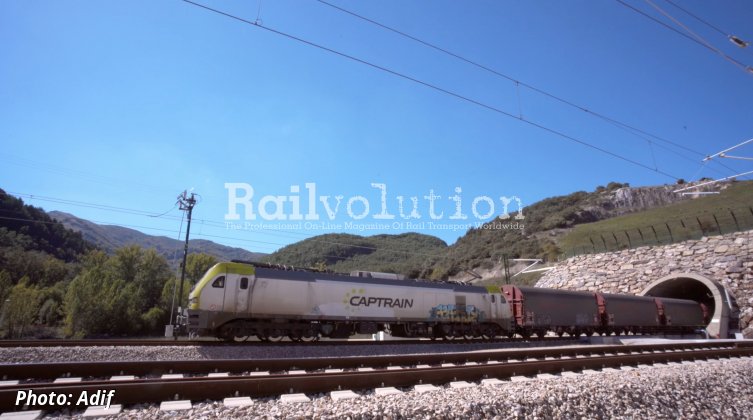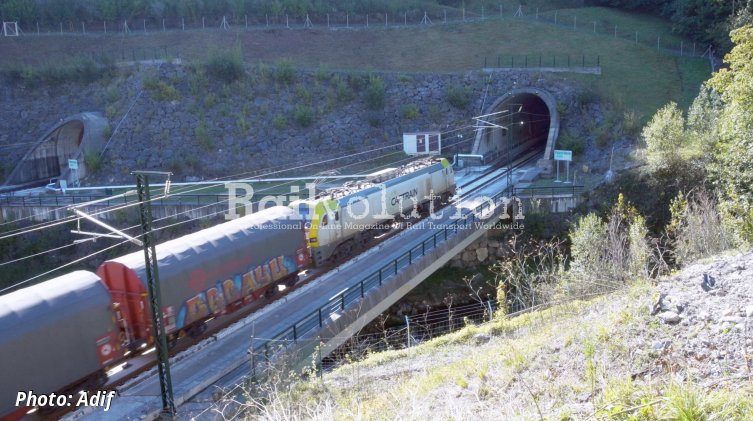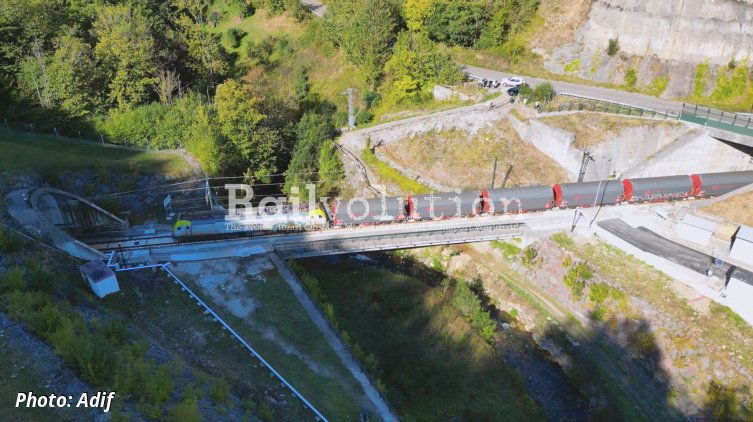Variante de Pajares inaugurated (2)
posted on 1st Jan 2024 22:31
Passenger services
The initial timetables are likely to change in early spring 2024 with the introduction of variable gauge Class 106 Avrils on AVE-branded services, replacing most if not all of those currently operated by Class 130s. There will then be a modest reduction in end-to-end journey times (the maximum line speed through the base tunnel is 275 km/h), together with an increase in service frequency, including a direct train between Avilés and Madrid. There will also be an Avril-operated AVLO service between Gijón and Madrid, stopping at all stations en route (including Mieres and Pola de Lena).
At 09.00 on 2 November 2023 Renfe put on sale 25,000 tickets at a flat fare of 18 EUR (Básico class) and 21 EUR (Elige class), the offer running from 30 November 2023 to 15 February 2024, for travel between Gijón or Oviedo and Madrid. By 13.00 over 12,000 of these tickets had been sold, being available online, by phone, from vending machines and (staffed) booking offices. In 15 days sales topped 50,000.
The Media Distancia service between Gijón and León, calling at all stations south of Pola de Lena, continues to operate until spring 2024, the end of the current timetable period, with a fare of 13.80 EUR between the two cities. It runs northbound in the mornings, ad southbound in the afternoons. At the time of writing (late November) it was impossible to access Alvia fares via the Renfe website, possibly because of customer demand.
The Asturias autonomous government estimates that the opening of the Variante will result in a significant increase in the number of passenger journeys made by rail to the Principality - from the current annual of 260,000 to around 600,000. It is also hoped that the new line will encourage leisure visitors to the Principality, though since one of the objectives of leisure travel is to savour spectacular landscapes, such as those visible from the train on the Rampa de Pajares, one can say very little of the views from the train window when passing through 40 km of tunnels.
The westernmost track between La Robla and Campomanes is 1,668 mm gauge only, and electrified at 25 kV. The easternmost track is mixed gauge, but also electrified at 25 kV. This is because it was impossible to build substations within the tunnel at the required intervals for 3 kV electrification.
All traffic using the Variante de Pajares is at present 1,668 mm gauge, the 1,435 mm gauge track is not used. This is because work is in progress to dual gauge the stretch between León and La Robla. In November 2023 this work was not very far advanced. So far there is no further news on the wagons ordered by Renfe Mercancías designed for gauge changing. The operation is regulary on the right track. However, the Variante counts on two-way Automatic Block system, and it is posible to operate equally on both directions according to trafic control requirements.
The 1,435 + 1,668 mm dual-track (east) is used just on 1,668 mm in the first stage of operation. That is, trains circulate just on 1,668 mm in both tracks (east and west) for the moment. The Campomanes gauge changer is not used in the first stage of operation. It will be used when 1,435 mm gauge is operational in the León - La Robla section. Then the León to Oviedo trains will enter on the 1,435 mm gauge and leave on the 1,668 mm gauge. The first trains to use the 1,435 mm gauge track will be the Class 106 AVRILs, in the spring of 2024, once handed over and commissioned.
There is of course the fact that freight operators with only diesel locomotives or 3 kV DC electrics are eliminated from the Variante. These, plus dangerous consignments, still use the original line, which will remain in use for the immediate future, possibly longer.
Freight and Accessibility
The first commercial freight over the new line was train 92868, with 256.109 hauling a trailing load of 810 tonnes of steel products from the ArcelorMittal works in Trasona, near Avilés. Journey time between Pola de Lena and La Robla as 42 minutes, compared with at least two hours via the line over the Rampa de Pajares. Maximum speed reached was 100 km/h, compared with between 61 and 75 km/h on the Rampa.
However, although the new line forms part of the future Atlantic Corridor, there are still certain obstacles to its barrier-free use by operators - both passenger and freight. First, a passenger operator in the high speed sector needs to have a fleet of variable-gauge, multi-system (25 kV 50 Hz and 3 kV DC) trains to access the Asturian network north of Pola de Lena. Only Renfe’s fleet meet this requirement at present.
Second, freight operators need to have a fleet of multi-system (25 kV 50 Hz and 3 kV DC) locomotives, or diesel-powered machines, for the same purpose. Only Renfe and Captrain España currently enjoy this luxury. There is of course no break of gauge problem. Otherwise, operators lacking such machines will be limited to using the Rampa de Pajares, whose long term future is uncertain.
MITMA reckons that to keep the Rampa operational, an investment of around 700 million EUR will be necessary over the coming 15 years. The line at present has numerous temporary speed restrictions, some as low as 30 km/h, and there are frequent incidents involving the life-expired catenary. In severe weather conditions there is also a real risk of landslides, while snow can be a problem in winter.
There is talk in some circles of maintaining the Rampa for use by tourist trains, but although this is a reasonable option, it is doubtful if such schemes would receive the support of the provincial tourism department. Given the great number of civil engineering features on this line – in particular the large number of tunnels – the possibility of getting it protected as a UNESCO industrial heritage site (à la Semmering, à la RhB) has been mentioned on occasions, though will very little progress as yet.
A recent exercise by ALSA Rail, conducted on Sunday 19 November 2023, with only limited publicity, involving a special low season day trip from Gijón and Pola de Lena to Villamanín, resulted in 200 out the 220 seats on the four-carriage train, hauled by an ALSA Class 269 electric, being sold. Passengers were a mix of railway enthusiasts and local people, and the trip took place in fine weather. ALSA Rail is considering the possibility of further similar excursions during the peak holiday season (July and August) in Asturias.
There is also a lesson to be learned by all from recent incidents in the rest of Europe where accidents or weather-related incidents have closed major freight and passenger arteries - the Gotthard Basistunnel, Rastatt, the Storebælt Bridge, and the coastal stretch of line between Dawlish and Teignmouth - for instance. An incident on the Variante de Pajares - such as a major landslide at Campomanes, or at any other location on an open air stretch of the line, or a fire and derailment inside the base tunnel with dual gauge track - would isolate Asturias by rail from the rest of Spain if the Rampa were not maintained in operational use. Moreover, should the Rampa be closed permanently, the 3 kV DC EMU fleet used for Cercanías operations in Asturias would be held prisoner, and would only be able to move to the rest of Spain under tow by 25 kV AC locomotives.
This matter was brought to a head by ALSA Rail, whose principal maintenance base is in Asturias, at Lugo de Llanera, while its rolling stock and motive power (ALCO diesels and Class 269 3 kV DC locomotives) are based in Madrid, with commercial activities embracing Zaragoza, Madrid and València. Movements of ALSA’s material to and from Lugo de Llanera take place quite frequently, but if the Rampa were closed to traffic, complications would occur. And the exclusion of many open access freight operators from asturias would prejudice not only the operators themselves (who would need to buy or lease 25 kV AC locomotives) but also the railfreight market in Asturias in general.
In May 2010 the Ministry of Public Works reckoned that each freight train was billed 909 EUR in access charges for using the Rampa (10.94 EUR per km for 83.1 km), while the access charge on the new line would be only 620 EUR (12.48 EUR per km for 46.2 km). The latter route, with its greater capacity, would enable a tripling of the number of freights crossing the Cordillera - up to 116 per day (58 in each direction).
High speed to Gijón?
The logical route for a high speed line from Pola de Lena to the coast was, in 2004, via Mieres (station), then to the Nalón valley to the west of Langreo (intermodal interchange serving the former coal mining towns), the Pola de Siero district (intermodal interchange serving an area whose population is rapidly increasing), Lugo de Llanera (interchange with the Renfe lines to Oviedo, Gijón and Avilés, and proximity to two major shopping malls) the Porceyu industrial estate complex to the south of Gijón (shopping malls and industrial complexes) and Cabueñes (adjacent to the city hospital and university complex, in the eastern suburbs, to be served by the cross-city underground extension of the Cercanías network, and in 2004 on the proposed AVE del Cantábrico high speed line, which would have linked the major urban centres on the north coast).
Although this route would have involved little in the way of major tunnelling, Public Works decided, around 2016, that a new line directly serving the centre of Oviedo, was the best option. 18 km long and double track 1,435 mm gauge between Pola de Lena and Soto del Rey, it would have had long tunnels under parts of the Sierra de Morcín, traversing a former coal mining zone in limestone terrain.
Between Soto del Rey, Oviedo and Lugo de Llanera (18.6 km) the existing line would become dual gauge. From Lugo de Llanera to Serín there would be another cut off, 7.8 km long, eliminating the great horseshoe curve in the vicinity of Villabona (the junction with the line to Avilés). On the final 11.1 km from Serín to Gijón the existing track would be dual-gauged. The cost was then put, very optimistically, at 1.604 billion EUR, and it was reckoned that the Gijón to Madrid journey time would be reduced to 2 h 36.
Over the following years this scheme was gradually pruned down, and given the present economic climate, it is unlikely to go ahead, apart from the possibility of dual-gauging the entire 1,668 mm gauge Asturian network.

